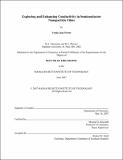Exploring and enhancing conductivity in semiconductor nanoparticle films
Author(s)
Porter, Venda Jane
DownloadFull printable version (2.045Mb)
Other Contributors
Massachusetts Institute of Technology. Dept. of Chemistry.
Advisor
Moungi G. Bawendi.
Terms of use
Metadata
Show full item recordAbstract
Semiconductor nanocrystals (NCs) are a promising material for use in opto-electronic devices as their optical properties tune with particle size. NCs formed via colloidal synthesis are suspended in solution by the organic ligands which passivate the NC surface after synthesis, and NCs can be deposited from solution to form NC solids. In theory, 'designer solids' having different electrical properties can be formed by changing, and even mixing, the types of NCs in the NC solids. However, the organic ligands capping each NC hinder charge transport between NCs in the solid. This thesis presents a study of how methods developed to enhance conductivity alter the physics of charge transport through the NC solid. Chapter 2 describes a post-deposition ligand exchange that decreases interparticle spacing and increases photogenerated current by over three orders of magnitude. In addition, the larger currents allow for the investigation of the nature of the CdSe NC/gold electrode interface which is found to impede electron and hole injection into the NC film. In Chapter 3 the electronic height of the tunnel barrier between CdSe NCs is changed by separating NCs with a thin ZnS inorganic shell rather than organic ligands. (cont.) The inorganic shell is found to passivate the NC surface better than the ligands. This reduces non-radiative exciton recombination and allows for large room temperature photocurrents. The semiconductor material is switched from CdSe to CdTe in Chapter 4 and, though CdTe NC films are composed of NCs having the same capping ligand and a similar size as those in the CdSe NC films, the conduction mechanism in the CdTe NC film is different. Specifically, holes rather than electrons are found to be the majority carrier and photocurrent amplification is observed. Finally, in Chapter 5 and Appendix A, the potential of CdTe and CdSe NC films in photovoltaic devices is investigated. In the study of CdSe/CdTe NC mixed films (Chapter 5) it is found that NC surface states reduce device efficiency. In multisize CdSe NC gradients (Appendix A) the characteristics of the NC/polymer interface are found to dominate charge transport.
Description
Thesis (Ph. D.)--Massachusetts Institute of Technology, Dept. of Chemistry, 2007. This electronic version was submitted by the student author. The certified thesis is available in the Institute Archives and Special Collections. Vita. Includes bibliographical references.
Date issued
2007Department
Massachusetts Institute of Technology. Department of ChemistryPublisher
Massachusetts Institute of Technology
Keywords
Chemistry.